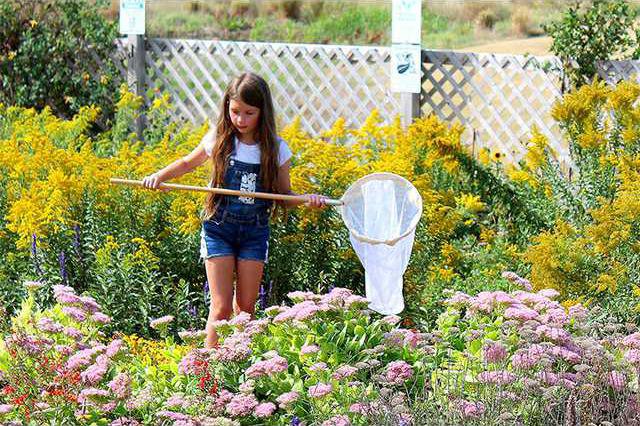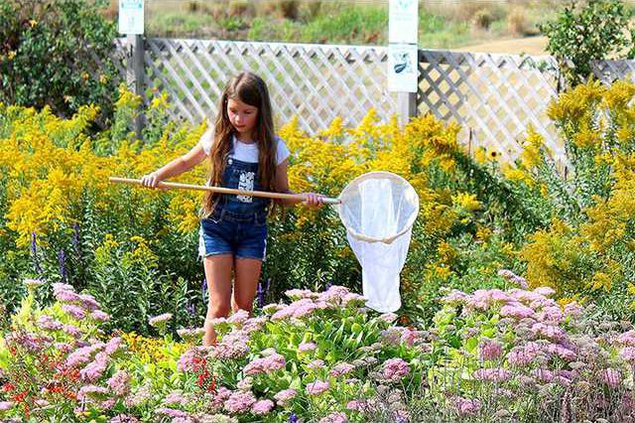Butterflies were in abundance at the Kansas Wetlands Education Center nature trail Saturday, enough to hold the interest of hundreds of young butterfly hunters and their parents, there for the 5th Annual KWEC Butterfly Festival.
One of the key features of the festival is the opportunity to tag Monarch butterflies. But with a plethora of Painted Lady butterflies lighting on the abundant native flowers along the nature trail, few Monarchs were actually tagged. Still, families attending the festival weren’t disappointed as they caught butterflies in nets and brought them to volunteers stationed along the nature trail for identification, then gently released them back to nature.
“Migration is really dependent on the weather, and its really hard to predict exactly when those Monarchs are going to come through this area,” said KWEC Director Curtis Wolf. Monitors for Monarch Watch, an ongoing research project of the University of Kansas, have been keeping tabs on the annual migration. “We’ve been watching reports this last week, and people are recording big congregations of them in Nebraska, but they’re waiting on the south wind to stop blowing before they make the trek down here.”
Festival draws visitors to Barton County
A casual survey of the KWEC parking lot indicated that the event was heavily attended by people from Barton County, but also Ellsworth, Harvey, Jefferson, Mitchell, Pawnee, Rice, Rush, Russell, Sedgwick and Stafford counties, and from Missouri, Oklahoma, Texas and Colorado.
Jennifer Uridel, Great Bend, brought her niece, Rayne Casey, 11, to the butterfly festival. She’s visiting from Colorado, and already has a keen interest in butterflies. “I’ve caught a lot of butterflies, but half the time I’ve accidentally stepped on them,” she said.
At home, she sees yellow, white and lavender colored butterflies on the garden flowers. The ones she saw at the KWEC Saturday morning are different than what she normally sees.
“I’ve learned that Monarch butterflies are kind of late coming this year,” she said. “Also, Monarch butterflies look the same on the bottom as they do on the top. Painted ladies are gray underneath.”
In addition to taking photos of her family catching butterflies, she photographed the signs along the nature tail that contained photos and information about the butterflies to share with a friend back home.
Brenda McMillon, Hays, was one of the lucky participants who caught and tagged a Monarch. She recorded the number so she could check online to see if hers is found months from now in Mexico, where the butterflies spend the winter months. According to the Monarch Watch website, most 2016 tags were recovered in El Rosario and Cella Pellon during the first quarter of 2017.
“We came last year and there were thousands of Monarchs,” she said. “Between a friend an me, we caught a dozen. We had so much fun, we had to come back and bring other people.”
This year, McMillon brought her daughter, Crystal Washington, Hutchison, and grandson Collin McMillon, Hays, came with cameras in tow. One captured the event in photos while the other shot video.
Tess Brewer, a graduate student and KWEC assistant, pointed out a few Monarchs that morning to people on the trail. The Monarchs, she said, are larger in size, with more distinct orange, black and white colorings, she said.
Milkweed critical food source for Monarchs
Inside, volunteers manned a table with live displays of the various stages of Monarchs, from eggs laid on leaves to caterpillars, the chrysalis stage and finally young Monarch butterflies.
Pam Martin, KS Dept. of Wildlife, Parks, and Tourism Education/Information Representative, has been raising Monarchs and other butterflies at KWEC for several years, and also tends the KWEC butterfly garden. She encourages the planting of milkweed, the plant Monarchs seek out to deposit eggs that will grow into the next generation in about a month’s time.
The plants were available in limited amounts Saturday. Her advice, plant them and mark the location. Milkweed are late emerging perennials, so it’s easy to forget where they are. Showy blooms present in August, and are a source for pollen for butterflies and bees. The leaves are what emerging caterpillars eat. Milkweed has been greatly diminished throughout North America with the widespread use of herbicides like glyphosate. In recent years, Monarch Watch has encouraged home gardeners and others to establish Monarch waystations by growing the plants as a garden flower.
At the education pavilion, children learned to make flower bombs from native wildflower seeds and common clay powder. They launched bombs into the nature path area with a sling shot. They also were given a bomb to launch in their own yard, part of an ongoing effort by groups like Monarch Watch to provide food and cover for Monarchs and other species of butterflies.
Other entertainment at the festival included an educational magic show provided by Steve Craig and Amy Short, “The Fishin Magicians,” and a costume booth outside where children were encouraged to don wings and pretend to be butterflies. Many families toured the butterfly garden at the KWEC entrance.
There will be opportunities for students in the coming weeks to tag Monarchs as they arrive in the area. Martin has a supply of 500 tags, and will be presenting programs about butterflies at area schools in the next two weeks. Also, groups from schools in Salina are also expected in the next week, and will do some butterfly tagging at that time.





